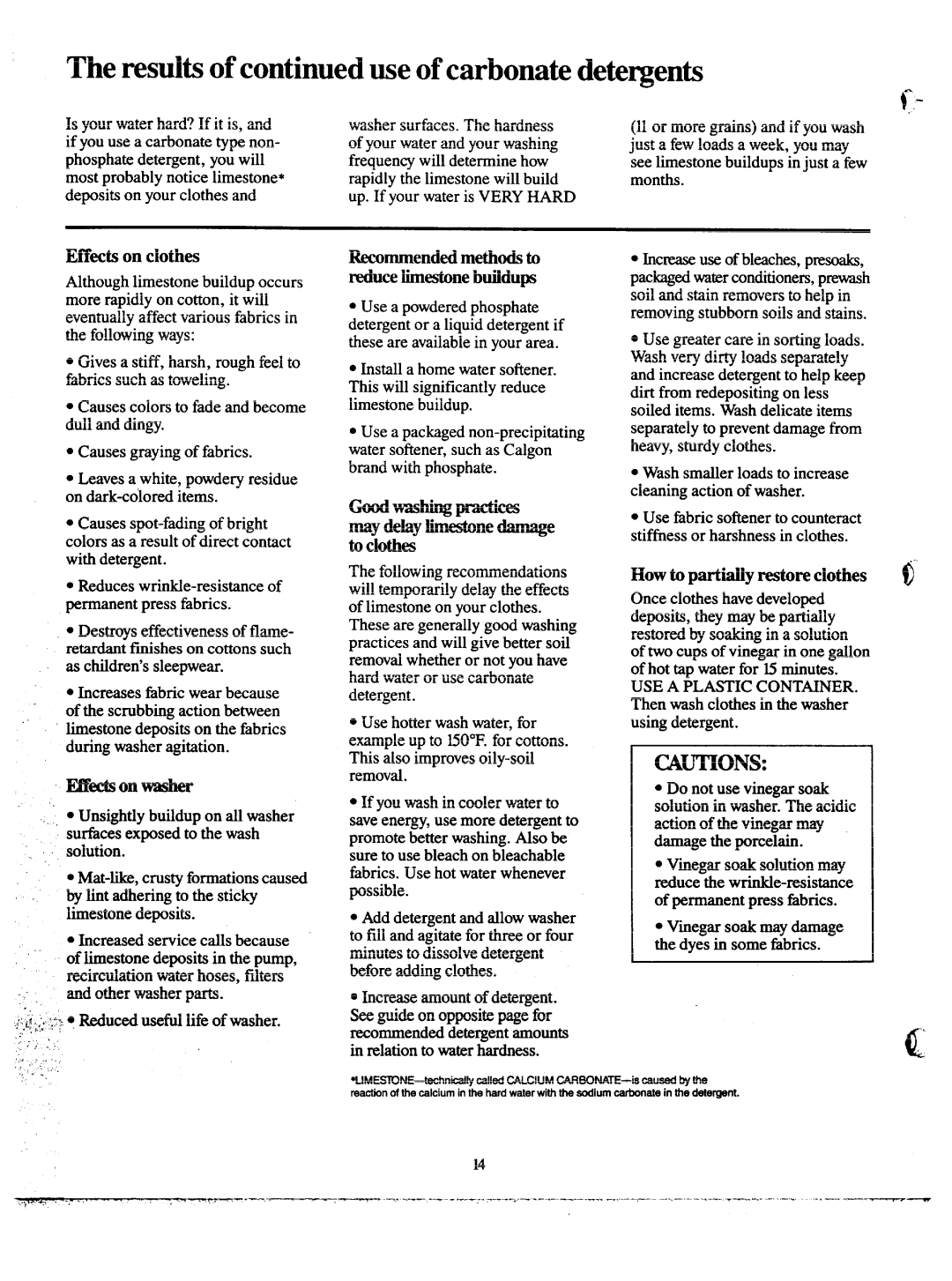
The results of continued use of carbonate detergents
r-
1s your water | hard? If it is, and | washer | surfaces. The | hardness | ||
if you use a carbonate | type non- | of your | water and your washing | |||
phosphate detergent, | you will | frequency will determine | how | |||
most probably | notice | limestone* | rapidly | the limestone | will build | |
deposits on your clothes and | up. If your water is VERY | HARD | ||||
(11or more grains) and if you wash | ‘ |
just a few loads a week, you may |
|
see limestone buildups in just a few |
|
months. |
|
Effixts on clothes
Although limestone buildup occurs more rapidly on cotton, it will eventually affect various fabrics in the following ways:
●Gives a stiff, harsh, rough feel to fabrics such as toweling.
●Causes colors to fade and become dull and dingy.
●Causes graying of fabrics.
●Leaves a white, powdery residue on
●Causes
●Reduces
●Destroys effectiveness of flarne- retardant finishes on cottons such as children’s sleepwear.
●Increases i%bric wear because
of the scrubbing action between limestone deposits on the fabrics during washer agitation.
~’ects on washer
QUnsightly buildup on all washer surfhces exposed to the wash solution.
.
●Increased service calls because of limestone deposits in the pump, recirculation water hoses, filters and other washer parts.
Recommended methods to reduce limestone buildups
●Use a powdered phosphate detergent or a liquid detergent if these are available in your area.
●Install a home water softener. This will significantly reduce limestone buildup.
●Use a packaged
Good washing practices may delay limestone damag e to clothes
The following recommendations will temporarily delay the effects of limestone on your clothes. These are generally good washing practices and will give better soil removal whether or not you have hard water or use carbonate detergent.
●Use hotter wash water, for example up to 150°F. for cottons. This also improves
●If you wash in cooler water to save energy, use more detergent to promote better washing. Also be sure to use bleach on bleachable fabrics. Use hot water whenever possible.
●Add detergent and allow washer to fill and agitate for three or four minutes to dissolve detergent before adding clothes.
●Increase amount of detergent. See guide on opposite page for
recotiended detergent tiounts in relation to water hardness.
●hlCXIXIXUse of bleaches, pHXlk& packaged water conditioned, prewash soil and stain removers to help in removing stubborn soils and stains.
●Use greater care in sorting loads. Wash very dirty loads separately and increase detergent to help keep dirt from redepositing on less soiled items. Wash delicate items separately to prevent damage from heavy, sturdy clothes.
●Wash smaller loads to increase cleaning action of washer.
s Use fabric softener to counteract stiffness or harshness in clothes.
.-
How to partially restore clothes $
Once clothes have developed deposits, they may be partially restored by soaking in a solution
of two cups of vinegar in one gallon of hot
USE A PLASTIC CONTMNER. Then wash clothes in the washer using detergent.
CAUTIONS:
●Do not use vinegar soak solution in washer. The acidic action of the vinegar may damage the porcelain.
●Viiegar soak solution may reduce the
●Vinegar soak may damage the dyes in some fabrics.
14
m. | ‘ “, “ | , ‘. | - | - | |||||||||||||||
| — |
|
|
|
|
